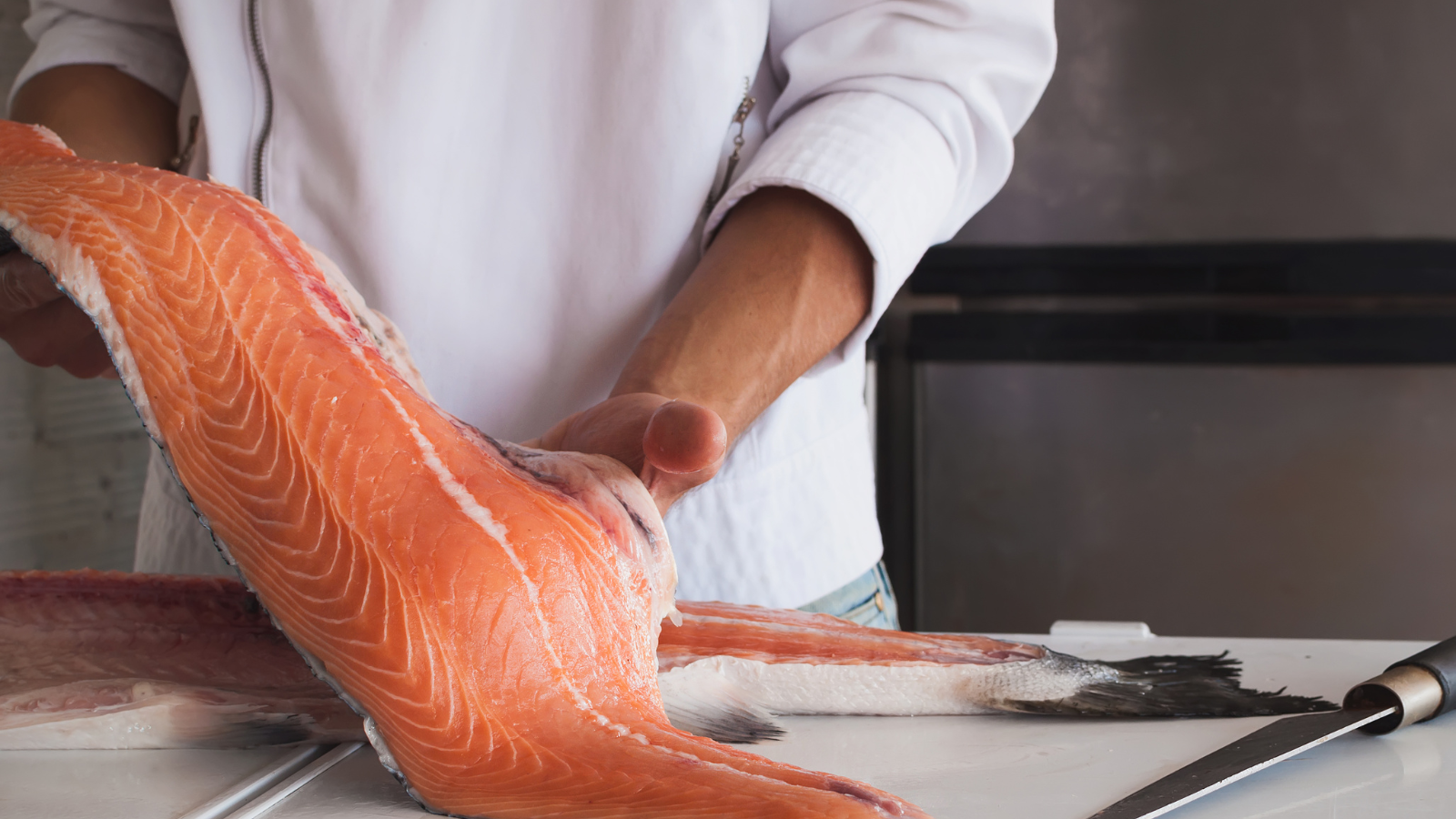
Can You Freeze Salmon? Save Fresh, Cooked, and Smoked Easily
Photo Credit: Canva Pro
It is safe and effective to freeze salmon to make it last longer. If you can't eat salmon within a few days, freezing it will help it stay fresh and tasty.
But it's important to use the right method to keep the texture and avoid freezer burn. Find out if you can freeze salmon, what happens to it when you do, and the best ways to store and eat salmon all year long.
Can You Freeze Salmon?
Photo Credit: Canva Pro
A simple and safe way to make fresh salmon last longer is to freeze it. If you buy fresh salmon and don't plan to cook it in the next two days, it's best to freeze it. If you freeze salmon the right way, it will keep its flavor and texture. This is true whether the salmon is cooked, smoked, or raw.
The Best Way to Freeze Salmon at Home
You need to carefully prepare salmon before freezing it so that it still tastes fresh. When you wrap something well, it keeps moisture inside and stops freezer burn.
-
Dry the salmon first: Pat it dry gently with a paper towel before wrapping.
-
Wrap tightly: Cover it first with plastic wrap, then with aluminum foil to block air.
-
Use a vacuum sealed bag: A vacuum sealer pulls out extra air and keeps salmon fresher.
-
Label and date: Write the freezing date clearly so you know how long it has been frozen.
How Long Can Frozen Salmon Last?
If you freeze and store salmon the right way, it will stay tasty in the freezer. To get good salmon, you need to know how long it can stay frozen.
-
Standard freezing: Wrapped salmon is best consumed within 3 months for optimal flavor, but it remains safe at 0°F for up to 6–8 months.
-
Vacuum sealed storage: Vacuum-sealed salmon can retain good quality for 6 to 12 months when kept at 0°F.
-
Watch for ice crystals: If you see ice crystals, it’s a sign of freezer burn.
-
Freeze flat: Place salmon flat on a baking dish if needed to freeze it evenly.
Why Is Salmon Not Suitable for Freezing?
Photo Credit: Canva Pro
You can freeze salmon, but not all kinds of salmon freeze well. When salmon is raw, ice crystals can form inside the flesh and make it less firm. Farm-raised salmon generally has more fat than many wild species, though wild king (Chinook) salmon is similarly high in fat.
How Freezing Affects Salmon’s Texture
If you freeze fish too slowly or without covering it, the texture will be terrible. The fish's structure is broken by the ice crystals.
-
Freeze quickly: Quick freezing reduces the size of ice crystals inside the fish.
-
Seal out air: Use an airtight container or vacuum sealer to protect the salmon.
-
Thaw gently: Always thaw frozen fish in the refrigerator overnight for best results.
-
Cook carefully: Quick cooking methods work best after thawing frozen fish.
Why Some Salmon Types Freeze Better Than Others
This is because some types of salmon freeze better because they have more fat in them. The texture is kept safe by the fat.
-
Choose fatty types: Farm raised salmon and king salmon handle freezing well.
-
Be careful with lean types: Sockeye and coho salmon are leaner and can become mushy.
-
Cook raw salmon gently: Slow, gentle heat protects the texture after freezing.
-
Fully thaw before cooking: Always cook fully thawed salmon to get the best texture.
Does Salmon Taste Different After Freezing?
Photo Credit: Canva Pro
If you thaw frozen fish the right way, it can still taste great. There may be small changes in taste and texture when you freeze raw or freeze cooked salmon. If you don't store salmon the right way, it can become dry or rubbery.
What Happens to Flavor After Freezing?
Most of the time, changes in taste are caused by air or freezer burn. If you store salmon the right way, you won't even notice a difference.
-
Smoked salmon freezes better: It holds flavor longer compared to raw fish.
-
Limit air exposure: Air can make leftover salmon taste dry and old.
-
Cook to the right internal temperature: Make sure thawed salmon reaches 145°F.
-
Don’t refreeze thawed salmon: If salmon has been partially frozen once thawed, cook it the same day.
Tips to Preserve the Best Salmon Taste
It's easy to make frozen fish taste as good as fresh. Handling is just as important as freezing.
-
Buy fresh salmon: Freeze it within up to two days for the best results.
-
Vacuum seal whenever possible: A vacuum sealed bag keeps flavor better than a Ziploc bag.
-
Thaw carefully: Always thaw frozen fish in cold water or in the refrigerator overnight.
-
Cook frozen salmon properly: If you cook frozen salmon without thawing, adjust the cooking time and use a baking dish to hold juices.
Can You Freeze Salmon in a Ziploc Bag?
Photo Credit: Canva Pro
You can freeze salmon in a Ziploc bag, but you have to do it the right way. This method is quick, but it doesn't protect the seafood as well as vacuum sealing. Salmon that is exposed to air may not stay fresh for as long and may get freezer burn or smell fishy after it has thawed.
Is Using a Ziploc Bag Enough?
If you don't prepare the fish properly, a Ziploc bag alone leaves the fish open to air. When this method is used, small changes must be made to keep the quality high.
-
Add water barrier: Place the fillet in lightly salted water inside the Ziploc to block air.
-
Remove all air: Press out as much air as possible before sealing the bag.
-
Lay flat: Freeze the seafood flat to help it thaw evenly later.
-
Use quickly: Fish frozen in a Ziploc should be used within a few months for the best taste.
Better Alternatives for Freezing Salmon
There are better ways to freeze fresh and wild fish. These ways are better at keeping texture and taste over time.
-
Vacuum sealing: A vacuum sealer removes all air and keeps the filets fresh longer.
-
Ice glazing: Dip the fillet in icy water several times to create a frozen coat before sealing.
-
Airtight containers: If no bags are available, use tight containers designed for food freezing.
How FullyHealthy Helps You Enjoy Top-Quality Salmon
FullyHealthy has options for wild seafood that is simple to store and cook. Their salmon products are great for people who want to make quick, tasty meals without having to worry about the quality. You can also use these things to make healthy meal plans and come up with easy recipes.
Wild Planet Salmon Options on FullyHealthy
FullyHealthy sells well-known brands that are known for having great taste and being healthy. The filets they caught in the wild are ready to be added to a lot of different dishes.
-
Wild Planet Wild Sockeye Salmon: Freshly caught, cooked once, and packed with nutrients.
-
Wild Planet Wild Alaskan Pink Salmon: Soft texture and rich taste, great for salads or casseroles.
Epic Smoked Maple Salmon Strip: A Convenient Snack
This is a great quick meal for when you need protein on the go. The meat is caught in the wild, and it's lightly seasoned to give it a sweet and savory taste.
-
High-protein snack: Great for hiking, workouts, or work lunches.
-
Clean ingredients: Simple seasoning without heavy sauces or artificial flavors.
-
Long shelf life: Easy to store in the fridge or pantry until you need a meal boost.
Final Thoughts
One easy way to keep salmon safe and ready for later meals is to freeze it. Put cooked salmon, fresh salmon, or smoked salmon in a vacuum-sealed bag, plastic wrap, or aluminum foil. These will help the salmon last longer. For the best taste, frozen fish should be eaten within three months. Salmon should always be kept in the fridge or freezer. When caught and cooked correctly, seafood is a tasty and healthy choice.
FAQs
How long can salmon stay frozen safely?
Frozen fish like salmon can stay fresh for up to three months if wrapped tightly in plastic wrap or kept in a vacuum sealed bag. If you buy fresh salmon, freeze it within up to two days to keep it delicious.
Can you cook frozen salmon without thawing?
Yes, you can cook frozen salmon directly. Place the fillet in a baking dish and bake it until the internal temperature reaches 145°F. Frozen seafood cooks better when thawed overnight in the fridge, but quick cooking also works.
Is it safe to refreeze thawed salmon?
You should not refreeze thawed salmon unless it stayed cold in the fridge and was not fully thawed. Raw salmon or cooked salmon should be consumed the same day once thawed fully to avoid bad taste or food risk.
Why does salmon sometimes taste fishy after freezing?
Poor sealing allows oxidation of fats, leading to off-flavors often described as 'fishy.' Vacuum sealing minimizes this risk. Ice crystals form and hurt the texture too. Vacuum sealed filets stay fresher and taste better after thawing.
What products help store salmon the best?
Using a vacuum sealer, airtight container, or thick Ziploc bag helps store seafood and meat better. Wild caught seafood, fresh filets, and cooked food can stay safe when sealed and frozen correctly. Good storage is part of every course in keeping your kitchen stocked smartly.

Leave a comment